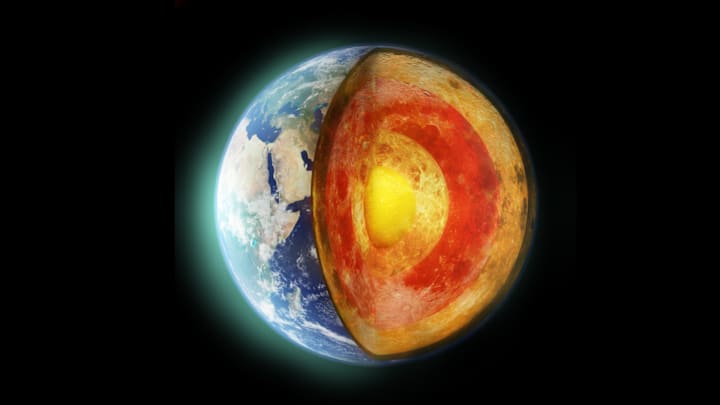If you undertook a journey to the center of the Earth in the manner of Jules Verne’s classic sci-fi novel, you wouldn’t come upon a herd of mastodons or a hidden sea where the plesiosaur swims free. What you would come upon would be temperatures so high and pressure so intense that you’d die long before you reached your goal: In fact, the deepest we’ve ever drilled into Earth is only about 7.6 miles.
But thanks in large part to seismic waves transmitted during earthquakes, scientists have been able to map out Earth’s unexplored interior. The planet is divided into four layers: the crust, mantle, outer core, and inner core. The top layer—the crust—is the thinnest, averaging roughly 19 miles thick beneath land and only around 3 miles thick beneath the ocean. That said, it can reach nearly 50 miles deep on land in some spots.
The lowest parts of the crust combine with the topmost layer of the upper mantle to form what’s known as the lithosphere, where tectonic plates are found. Under that is the mantle’s asthenosphere, then the lower mantle, and then another combination layer between the lower mantle and outer core that scientists call D” (pronounced “D double-prime”). Altogether, the mantle is Earth’s thickest layer, with an average radius of around 1800 miles—though, again, this varies by location.

The mantle comprises mostly solid rock, and most of those rocks are silicon-oxygen compounds known as silicates. Olivine and garnet are a couple major players in that category. Non-silicate elements include iron, potassium, calcium, and more. It’s also extremely hot in the mantle, with temperatures ranging from around 1830°F to nearly 6700°F.
Below the mantle is the roughly 1370-mile-thick outer core, consisting primarily of liquid nickel and iron. And, finally, the inner core: a sphere of solid iron (among other things) with a radius of nearly 760 miles. At over 9300°F, the inner core is definitely hot enough to melt that iron—but it doesn’t. Scientists think the pressure bearing down on the core from all the layers above it (and the atmosphere) may be keeping the iron in solid form.
If you add up the mileage of both the inner and outer core, it’s technically more than that of the mantle. But since the two are typically considered separate layers, the mantle is most often cited as the Earth’s thickest slice.
